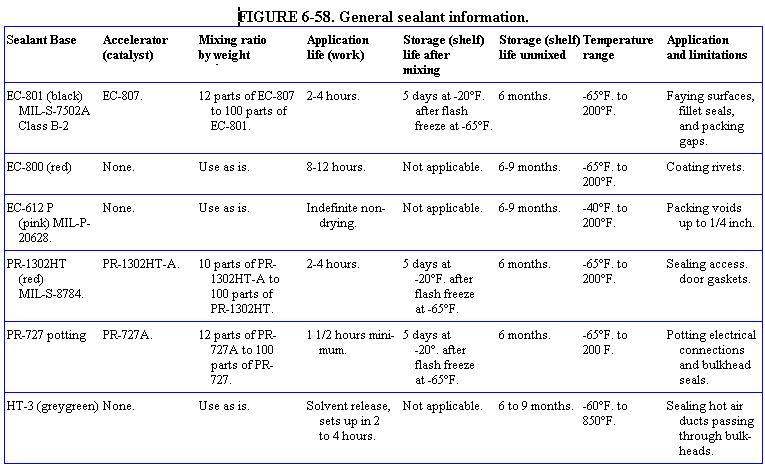

Certain areas of all aircraft are sealed to withstand pressurization by air, to prevent leakage of fuel, to prevent passage of fumes, or to prevent corrosion by sealing against the weather. Most sealants consist of two or more ingredients properly proportioned and compounded to obtain the best results. Some materials are ready for use as packaged, but others will require mixing before application.
One Part Sealants
One part sealants are prepared by the manufacturer and are ready for application as packaged. However, the consistency of some of these compounds may be altered to satisfy a particular method of application. If thinning is desired, the thinner recommended by the sealant manufacturer should be used.
Two Part Sealants
Two part sealants are compounds requiring separate packaging to prevent cure prior to application and are identified as the base sealing compound and the accelerator. Any alteration of the prescribed ratios will reduce the quality of the material. Generally two part sealants are mixed by combining equal portions (by weight) of base compound and accelerator.
All sealant material should be carefully weighed in accordance with the sealant manufacturer's recommendations. Sealant material is usually weighed with a balance scale equipped with weights specially prepared for various quantities of sealant and accelerator.
Before weighing the sealant materials, both the base sealant compound and the accelerator should be thoroughly stirred. Accelerator which is dried out, lumpy, or flaky should not be used. Preweighed sealant kits do not require weighing of the sealant and accelerator before mixing when the entire quantity is to be mixed.
After the proper amount of base sealant compound and accelerator has been determined, add the accelerator to the base sealant compound. Immediately after adding the accelerator, thoroughly mix the two parts by stirring or folding, depending on the consistency of the material. The material should be mixed carefully to prevent entrapment of air in the mixture. Too rapid or prolonged stirring must be avoided as it will build up heat in the mixture and will shorten the normal application time (working life) of the mixed sealant.
To ensure a well mixed compound, it may be tested by smearing a small portion on a clean, flat metal or glass surface. If flecks or lumps are found, continue mixing. If the flecks or lumps cannot be eliminated, the batch should be rejected.
The working life of mixed sealant is from one-half hour to 4 hours (depending
upon the class of sealant); therefore, mixed sealant should be applied
as soon as possible or placed in refrigerated storage. Figure 6-58 presents
general information concerning various sealants.

 |
The curing rate of mixed sealants varies with changes in temperature and humidity. Curing of sealants will be extremely slow if the temperature is below 60° F. A temperature of 77° F with 50 percent relative humidity is the ideal condition for curing most sealants.
Curing may be accelerated by increasing the temperature, but the temperature should never be allowed to exceed 120° F at any time in the curing cycle. Heat may be applied by using infrared lamps or heated air. If heated air is used, it must be properly filtered to remove moisture and dirt.
Heat should not be applied to any faying surface sealant installation until all work is completed. All faying surface applications must have all attachments, permanent or temporary, completed within the application limitations of the sealant.
Sealant must be cured to a tack free condition before applying brush top coatings. (Tack free consistency is the point at which a sheet of cellophane pressed onto the sealant will no longer adhere.)